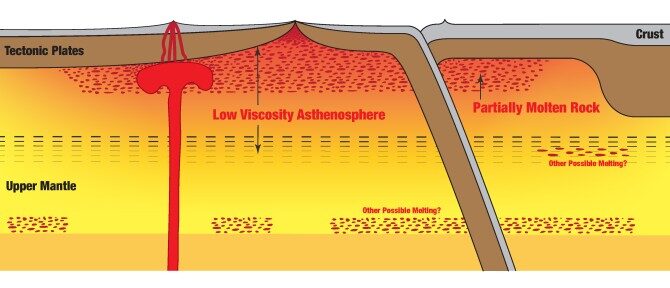
Researchers had previously identified patches of melt at a similar depth. But a new study led by The University of Texas at Austin revealed for the first time the layer's global extent and its part in plate tectonics.
The research was published Feb. 6, 2023, in the journal Nature Geoscience.
The molten layer is located about 100 miles from the surface and is part of the asthenosphere, which sits under the Earth's tectonic plates in the upper mantle. The asthenosphere is important for plate tectonics because it forms a relatively soft boundary that lets tectonic plates move through the mantle.
The reasons why it is soft, however, are not well understood. Scientists previously thought that molten rocks might be a factor. But this study shows that melt, in fact, does not appear to notably influence the flow of mantle rocks.
"When we think about something melting, we intuitively think that the melt must play a big role in the material's viscosity," said Junlin Hua, a postdoctoral fellow at UT's Jackson School of Geosciences who led the research. "But what we found is that even where the melt fraction is quite high, its effect on mantle flow is very minor."

Showing that the melt layer has no influence on plate tectonics means one less tricky variable for computer models of the Earth, said coauthor Thorsten Becker, a professor at the Jackson School.
"We can't rule out that locally melt doesn't matter," said Becker, who designs geodynamic models of the Earth at the Jackson School's University of Texas Institute for Geophysics. "But I think it drives us to see these observations of melt as a marker of what's going on in the Earth, and not necessarily an active contribution to anything."
The idea to look for a new layer in Earth's interior came to Hua while studying seismic images of the mantle beneath Turkey during his doctoral research.
Intrigued by signs of partly molten rock under the crust, Hua compiled similar images from other seismic stations until he had a global map of the asthenosphere. What he and others had taken to be an anomaly was in fact commonplace around the world, appearing on seismic readings wherever the asthenosphere was hottest.
The next surprise came when he compared his melt map with seismic measurements of tectonic movement and found no correlation, despite the molten layer encompassing almost half the Earth.
"This work is important because understanding the properties of the asthenosphere and the origins of why it's weak is fundamental to understanding plate tectonics," said coauthor Karen Fischer, a seismologist and professor at Brown University who was Hua's Ph.D. advisor when he began the research.
The research was funded by the U.S. National Science Foundation. Collaborating institutions included the UT Oden Institute for Computational Engineering and Sciences and Cornell University.



Reader Comments
Full Professor
Behavioural Neuroscience, Biomolecular Sciences and Human Studies
Departments of Psychology and Biology
Laurentian University,
Sudbury, Ontario, Canada P3E 2C6
The expansions create more crust, but obviously at lower levels than the original. Oceanic crust is made. Seems the Old Testament has scientific relevance as it contains witness reports.
What happens when the amount of magma is not sufficient? Apollo aka asteroid belt.... happened when it was in the third orbital poition.
I love how one scientific expert contradicts another scientific expert....
We really are getting good value for money in the realm of science....
Im still burning gas and wood and my incandesent light bulb still works....the only thing I've learned from it all is how to foot the bill lol.